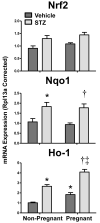Renal efflux transporter expression in pregnant mice with Type I diabetes
- PMID: 22531820
- PMCID: PMC3370395
- DOI: 10.1016/j.toxlet.2012.04.008
Renal efflux transporter expression in pregnant mice with Type I diabetes
Abstract
Prior research suggests that sex hormones and metabolic changes, such as obesity and hyperglycemia, can alter renal transporter expression in rodents. The purpose of this study was to characterize the expression of kidney efflux transporters and regulatory transcription factors in response to Type I diabetes and pregnancy. Female C57BL/6 mice were treated with multiple low doses of streptozotocin (STZ) to induce hyperglycemia and then mated with normoglycemic male mice. Transporter mRNA and protein expression were quantified in kidneys from vehicle- and STZ-treated non-pregnant and pregnant mice on gestation day 14. Pregnancy decreased the expression of Mdr1b, Mrp4, and 5 proteins and increased the mRNA and protein expression of Mrp3 by 50-60%. STZ treatment elevated Mrp1, 2, 4, and 5 and reduced Mrp3, 6, and Mdr1b mRNA and/or protein in non-pregnant mice. Pregnancy had little effect on STZ-mediated changes in renal efflux transporter expression. Transcriptional profiles of Hnf1α, PXR, AhR, and Nrf2 were altered in patterns similar to some efflux transporters suggesting potential involvement in their regulation. Taken together, these results suggest that renal drug efflux transporters and regulatory signaling pathways are altered by endocrine and metabolic changes that occur during pregnancy and Type I diabetes.
Copyright © 2012 Elsevier Ireland Ltd. All rights reserved.
Figures







Similar articles
-
Pregnancy represses induction of efflux transporters in livers of type I diabetic mice.Pharm Res. 2013 Sep;30(9):2209-20. doi: 10.1007/s11095-013-0981-z. Epub 2013 Jan 15. Pharm Res. 2013. PMID: 23319174 Free PMC article.
-
ANIT-induced intrahepatic cholestasis alters hepatobiliary transporter expression via Nrf2-dependent and independent signaling.Toxicol Sci. 2009 Apr;108(2):247-57. doi: 10.1093/toxsci/kfp020. Epub 2009 Jan 29. Toxicol Sci. 2009. PMID: 19181614 Free PMC article.
-
Gender differences in mRNA expression of ATP-binding cassette efflux and bile acid transporters in kidney, liver, and intestine of 5/6 nephrectomized rats.Drug Metab Dispos. 2008 Jan;36(1):16-23. doi: 10.1124/dmd.107.014845. Epub 2007 Sep 12. Drug Metab Dispos. 2008. PMID: 17855625
-
Induction of the multidrug resistance-associated protein family of transporters by chemical activators of receptor-mediated pathways in mouse liver.Drug Metab Dispos. 2005 Jul;33(7):956-62. doi: 10.1124/dmd.105.003798. Epub 2005 Apr 15. Drug Metab Dispos. 2005. PMID: 15833929
-
Induction of phase I, II and III drug metabolism/transport by xenobiotics.Arch Pharm Res. 2005 Mar;28(3):249-68. doi: 10.1007/BF02977789. Arch Pharm Res. 2005. PMID: 15832810 Review.
Cited by
-
An update on the physiologic changes during pregnancy and their impact on drug pharmacokinetics and pharmacogenomics.J Basic Clin Physiol Pharmacol. 2021 Dec 8;33(5):581-598. doi: 10.1515/jbcpp-2021-0312. eCollection 2022 Sep 1. J Basic Clin Physiol Pharmacol. 2021. PMID: 34881531 Free PMC article. Review.
-
Quantitative Proteomics Reveals Changes in Transporter Protein Abundance in Liver, Kidney and Brain of Mice by Pregnancy.Drug Metab Lett. 2018;12(2):145-152. doi: 10.2174/1872312812666180625122810. Drug Metab Lett. 2018. PMID: 29938623 Free PMC article.
-
Multidrug resistance-associated protein 4 (Mrp4) is a novel genetic factor in the pathogenesis of obesity and diabetes.FASEB J. 2021 Feb;35(2):e21304. doi: 10.1096/fj.202001299RR. FASEB J. 2021. PMID: 33417247 Free PMC article.
-
Endocrine and metabolic regulation of renal drug transporters.J Biochem Mol Toxicol. 2012 Oct;26(10):407-21. doi: 10.1002/jbt.21435. Epub 2012 Aug 29. J Biochem Mol Toxicol. 2012. PMID: 22933250 Free PMC article. Review.
-
Altered Expression of Transporters, its Potential Mechanisms and Influences in the Liver of Rodent Models Associated with Diabetes Mellitus and Obesity.Eur J Drug Metab Pharmacokinet. 2016 Jun;41(3):199-210. doi: 10.1007/s13318-015-0306-1. Eur J Drug Metab Pharmacokinet. 2016. PMID: 26597190 Review.
References
-
- Aleksunes LM, Scheffer GL, Jakowski AB, Pruimboom-Brees IM, Manautou JE. Coordinated expression of multidrug resistance-associated proteins (Mrps) in mouse liver during toxicant-induced injury. Toxicol Sci. 2006;89:370–379. - PubMed
Publication types
MeSH terms
Substances
Grants and funding
LinkOut - more resources
Full Text Sources
Medical

